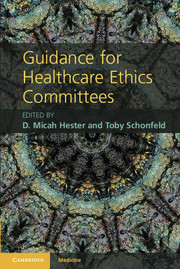Book contents
- Frontmatter
- Contents
- Contributors
- Preface
- Section 1 The Context of Healthcare Ethics Committee Work
- 1 Introduction to healthcare ethics committees
- 2 Brief introduction to ethics and ethical theory
- 3 Healthcare ethics committees and the law
- 4 Cultural and religious issues in healthcare
- Section 2 Consultation
- Section 3 Policy Development and Organizational Issues
- Section 4 Educating Others
- Index
- References
2 - Brief introduction to ethics and ethical theory
Published online by Cambridge University Press: 05 August 2012
- Frontmatter
- Contents
- Contributors
- Preface
- Section 1 The Context of Healthcare Ethics Committee Work
- 1 Introduction to healthcare ethics committees
- 2 Brief introduction to ethics and ethical theory
- 3 Healthcare ethics committees and the law
- 4 Cultural and religious issues in healthcare
- Section 2 Consultation
- Section 3 Policy Development and Organizational Issues
- Section 4 Educating Others
- Index
- References
Summary
Objectives
Explain how the terms ethics and morality refer to a family of related concepts.
Identify a variety of common sources of moral guidance and authority.
Describe several approaches to ethics and explain the value of ethical discourse (a systematic approach to ethics).
Use an ethical theory and its associated methods to help identify, clarify, and analyze clinical ethics issues.
Case
Janet S. is a 65-year-old stage 4 breast cancer patient whose third round of chemotherapy has failed. She knows her status well, as she suffers from significant pain from bone metastases. In thoughtful conversationwith you, her oncologist, she asks for your help in hastening her death. She states clearly to you that she finds her life insufferable and that dying quickly while she still has some “dignity” is of utmost importance to her. She has made peace with her friends and family and states that she is ready to die.
Introduction: The meaning of “ethics”
“Ethics” is a term that lends itself to multiple meanings. Beginning with an understanding of both definitional and conceptual diferences among these meanings provides a starting place to difuse tensions caused by such diferences and may help to clarify the purpose of HECs in an organization.
- Type
- Chapter
- Information
- Guidance for Healthcare Ethics Committees , pp. 9 - 16Publisher: Cambridge University PressPrint publication year: 2012

